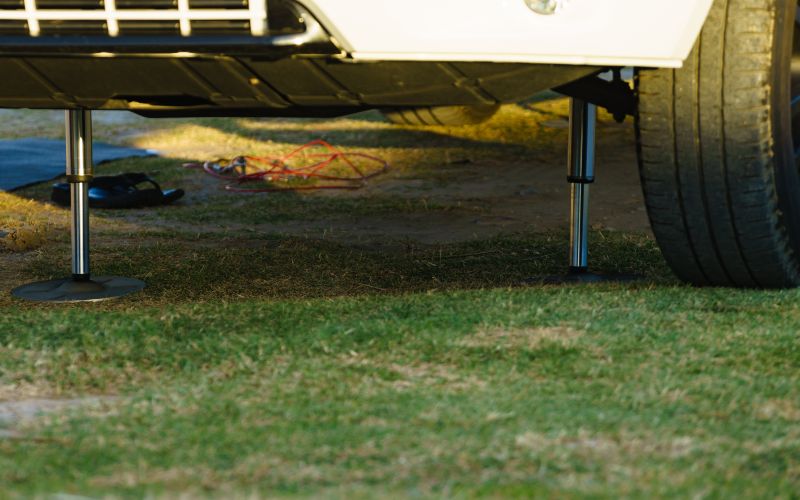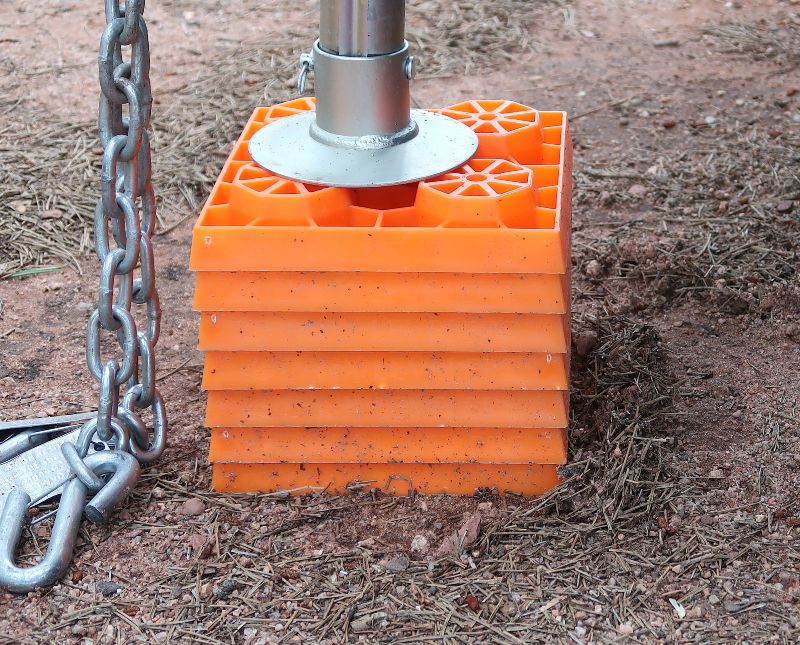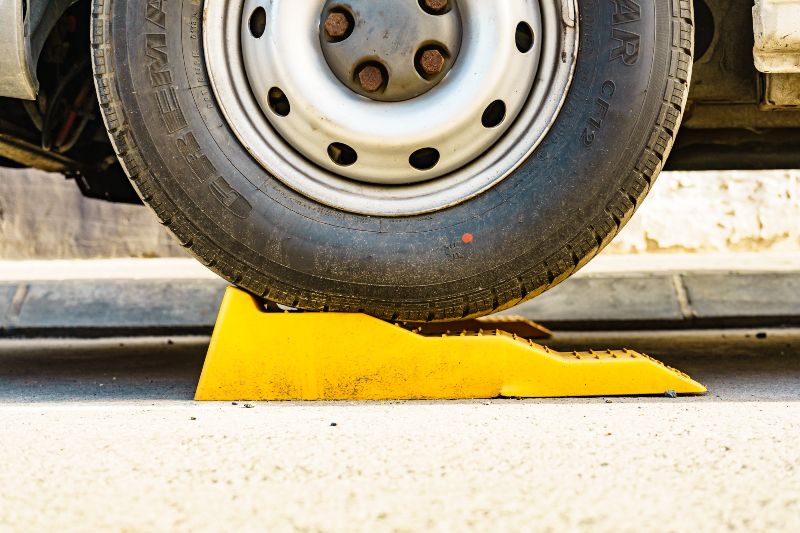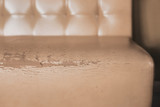Level the Playing Field: Looking at Manual and Automated RV Leveling Systems | RecPro
Do you know what's important for any RV owner? The RV leveling system. An RV leveling system keeps your rig nice and even to help ensure a comfortable and stable living space while on the road. Keeping your RV level also goes a long way in preventing appliances from malfunctioning. Having a proper RV leveling system is a vital aspect of your rig for a smooth and enjoyable camping experience, whether you're a full-time RVer or a weekend warrior. Let's explore the different types of RV leveling systems, how they are put together, and the benefits each one offers you. We will also discuss leveling your RV is important to your safety.
Function of Leveling Equipment
Leveling jacks are important for RV owners because they allow the vehicle to be level when parked on uneven ground. This helps to ensure that the RV is stable and safe to occupy. Without leveling jacks, an RV that is parked on uneven ground can lean or tilt, which can cause discomfort for the occupants and can also damage the RVs appliances, furniture, and structure over time.
Leveling jacks also help to prevent water from pooling in certain areas of the RV when parked on sloped terrain. This can help to prevent leaks and water damage to the RV. Additionally, jacks can help to ensure that the RV's appliances, such as the refrigerator, furnace, water heater, and stove are working properly. These appliances are designed to work on a level surface, so if the RV is not level, they will not function properly and may be damaged over time or be unsafe to use before leveling.
Overall, leveling jacks are an essential component of any RV, providing safety, stability, and comfort for the occupants and protecting the RV's appliances and structure.
Automated Systems v. Manual Systems
 An automated RV leveling system typically includes a control panel with a touch screen or similar display, leveling sensors, and electric or hydraulic leveling jacks. The sensors detect the level of the RV and provide feedback to the control panel, which then automatically extends or retracts the leveling jacks as needed to level the vehicle. The touch screen display allows for easy operation and monitoring of the leveling process.
An automated RV leveling system typically includes a control panel with a touch screen or similar display, leveling sensors, and electric or hydraulic leveling jacks. The sensors detect the level of the RV and provide feedback to the control panel, which then automatically extends or retracts the leveling jacks as needed to level the vehicle. The touch screen display allows for easy operation and monitoring of the leveling process.
A manual RV leveling system, on the other hand, typically includes manual leveling jacks, chocks, and leveling blocks. The jacks are typically operated by a hand crank or a drill, and the user must manually adjust the jacks to level the RV. The chocks and leveling blocks are then placed under the wheels and are used to provide additional stability to the vehicle while it is parked. Chocks come in a couple of different styles, which we will explore below.
In short, an automated RV leveling system is more convenient and easier to operate, but it requires more complex and expensive components, while a manual RV leveling system is less expensive, but requires significantly more effort, time, and finesse to level the vehicle.
How long does it take it deploy?
The amount of time it takes to manually level an RV depends on a few factors, such as the size of the RV, the type of leveling jacks used, and the degree of unevenness of the ground. Typically, it can take anywhere from a few minutes up to an hour to manually level an RV. The main factor as stated before, is the degree of unevenness of the ground. Therefore choosing your campsites carefully, based on surface levelness can save you a lot of time and energy during setup.
The automated system will be considerably faster, with a maximum deployment time of ~10 minutes. The speed of an automated system depends on the type, number and placement of jacks (hydraulic vs pneumatic vs electric) as well as the size and weight of your RV. Any way you slice it though, the automatic system is going to be significantly faster and less energy intensive than manual setup.


Components of a Manual Leveling Kit
The first step in manually leveling an RV is to check the level of the RV using a leveler tool, such as a bubble or digital level. Once the level of the RV has been determined, the leveling jacks can be extended or retracted as needed to raise or lower the RV until it is level. Oftentimes owners will have an electric drill for this purpose, as it can actuate the scissor jacks much faster than by hand.
Chocks and leveling blocks are used to provide additional stability and levelness to an RV when it is parked on uneven ground. To use chocks, place them on either side of the RVs wheels and adjust the position of the chocks until the wheels are securely wedged in place. This helps to prevent the RV from rolling or sliding while parked. There is another style of wheel chock which expands between wheels, but both types will achieve the same effect.
To use leveling blocks, you will first need to level the RV using leveling jacks or other leveling methods. Once the RV is level, place the leveling blocks under the wheels on the low side of the RV to raise the wheel and level the RV. It's important to note that leveling blocks come in different sizes and thicknesses, so it's best to use multiple blocks of different sizes to achieve the desired levelness. Also, the blocks should be placed under the wheels on the low side of the RV until the RV is level.
It's important to use chocks and leveling blocks in conjunction with one another for maximum stability. Chocks will keep the RV from moving while leveling blocks assist with leveling the RV.
Level, Plumb and True
To sum up, leveling equipment is an important piece of kit for safe and comfortable RVing. It ensures that the RV is stable and safe to occupy, prevents water from pooling, and keeps appliances working properly.
There are two main options available for RV leveling: manual and automated systems. Manual leveling systems are typically less expensive and require more effort and time to level the RV, while automated leveling systems are more convenient and can level the RV faster but usually require more investment. Chocks and leveling blocks are additional components that provide additional stability to the RV when it is parked on uneven ground. Whether you choose manual or automated leveling system, it is vital to ensure that your RV is level and stable before occupying it to ensure a comfortable and safe RVing experience!
How long does usually it take you to get your RV leveled? Let us know in the comments!
Recent Posts
-
How to Keep Your Pets Safe While Camping
RVing and camping are a great getaway from the hustle and bustle of work and the city and the day-to …Jul 2nd 2024 -
Why Replace Your RV Furniture?
You may wonder when is the best time to replace your RV furniture. There is no one right answer to t …May 20th 2024 -
Can You Put Regular Furniture in an RV?
Many new and old RV owners ask themselves this question when they feel the need to update th …Apr 25th 2024 -
4 Tips for Securing RV Furniture While Traveling | RecPro
How To Secure RV Furniture There are few things that beat going out on an adventure with an RV …Apr 25th 2024 -
How To Keep RV Furniture From Peeling
Peeling RV Furniture | Why it Peels and How to Stop it Your RV furniture is a point of pride on yo …Apr 25th 2024 -
Turning up the Heat With an RV Fireplace
There’s an unlimited number of cool and exciting features you could add to your recreational vehicle …Apr 25th 2024







